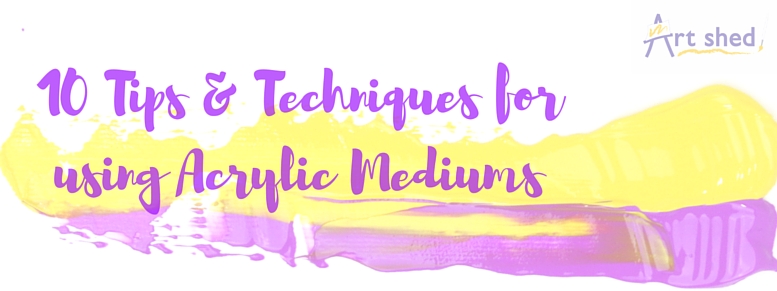10 Tips and Techniques for using Acrylic Mediums
Author: Tom Date Posted:15 July 2016

Acrylic Mediums for Beginners: Taking Acrylic Paint to the next level with 10 Techniques and Mediums to try.
Acrylic Paints are often recommended to new painters or beginners, as they are relatively affordable and simple to use. Most people believe that because they are water-soluble, they should use or mix water to paint with them; but did you know acrylic paint is most effective and versatile when used with mediums? There are a huge variety to choose from which appeals to a wide spectrum of artists at all skill levels. Medium is water soluble also, and helps the paint flex and adhere to the surface, and promotes even drying to avoid cracking - there are also specialized mediums for creating textures and effects. Here are ten things to try with your acrylic painting to expand your practice:
1. No additives - Acrylics are actually great to use straight from the tube, as long as you don’t work more than half a cm thick or so. It’s easy to build up texture in this way, and most acrylic paints dry to a semi-gloss finish.
2. Water – Water has its place with acrylics. Watered down, they behave a bit like water colours with transparent washes, dripping, running and bleeding. Like this, they will dry quickly and matte, but they can degrade over time due to the water breaking apart the plastic content.
3. General Medium (Liquid) – Liquid medium will thin and extend paint without losing opacity and intensity of the colour. Liquid mediums such as Atelier Clear Painting Medium, or Jo Sonja’s Flow control medium helps the paint move more freely across the canvas.
4. General Mediums (Gel) – Gel mediums serve the same purpose as liquid mediums, but have a thicker consistency that can help blending and create chunky brush strokes.
5. Retarder (Gel or liquid) – Is designed to slow down the dry time of acrylic paints to allow for ‘wet-in-wet’ techniques like smooth blends and easy removal of paint.
6. Impasto – a type of medium with an extremely solid, thick consistency designed to produce very thick textures without risk of the paint cracking as it dries. Clear drying and great with a palette knife!
7. Moulding/ Modelling Paste - not actually a medium, but used to create texture on the surface before you begin painting, a bit like a thick gesso. You can also choose to mix it with your paint, and because it is usually opaque white, it will tint your paint lighter.
8. Fixer/ Fast medium – A good example is Atelier Interactiv’s Fast Fixer medium. This can be mixed with paint to promote quick drying, useful for rapid layering without loss of colour. It also makes ‘locks’ paint in place, meaning it is resistant to scratching and washing back if you use it as a medium, or just a clear protective layer.
9. Glaze medium (Liquid or gel) – Used for glazing techniques. Use only a tiny dab of paint with a good amount of medium so it is barely visible. Layer on top of a finished image to enhance contrast and colours.
10. Texture Gels – Some manufacturers produce thick mediums that contain additives like sand, glass beads, or fibres to be mixed with paint and create a variety of textured finishes. Liquitex have a great range of texture gels which are super fun and easy to use like an impasto.
I recommend having at least one or two mediums in your painting kit to give you a broad range of possibilities for your art. The best way to learn about mediums is to experiment and play.
You can browse our comprehensive range of mediums Here -> Art Shed Acrylic Mediums
Comments (1)
The Best Acrylic Painting Mediums
By: dylan leo on 8 February 2022Thanks for sharing your thoughts. Nice tips you have shared. Hope it will help everyone of us those who saw your blog.








